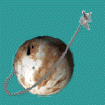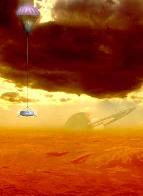
Current Issues:
SpaceViews
SpaceViews Update
Breaking News
Back Issues
Search
Subscriptions
Submissions
Forum
Space Sites of the Week
Home
Comet Hale-Bopp
Top Ten Stories of '96
Life on Mars?
Mars Pathfinder
Space Station Mir
Articles * Science * Journey * RTG Debate
| SpaceViews Poll | |
|---|---|
| There is considerable debate over Cassini's RTGs, which use plutonium. Do you believe, as NASA and other experts have stated, that it is safe to launch Cassini as planned? | |
| The poll is now over | |
| You can also check out an online Cassini poll at e-Poll through October 24. | |
On October 15, 1997 NASA launched the Cassini mission to Saturn. Billed as the last of the giant planetary science missions, it is a relic in an era where smaller, faster, cheaper spacecraft like Mars Pathfinder have become dominant. Cassini will spend almost seven years traveling more than a billion kilometers from Earth to Saturn. Once there it will spend at least four years studying the planet, its rings and magnetosphere, and its moons, including Titan, one of the most intriguing worlds in the entire solar system.
Regardless of the scientific advances the Cassini mission promises, the billion-dollar spacecraft met with harsh opposition from some anti-nuclear activists, who are against the use of over 30 kilograms of plutonium as part of the spacecraft's power supply. They fear an accident during launch or during an Earth flyby two years later could release amounts of plutonium which they claim could kill millions of people. These claims have been countered by NASA officials and many space activists, who state that the threat of contamination by the spacecraft's plutonium supply is negligably small.
Are the dangers from the spacecraft's power supply really as bad as some activists claim? What is involved in Cassini's journey to Saturn? And why go to Saturn in the first place? This special SpaceViews section will provide information to help answer those questions, and point you in the direction of additional resources to learn more about this extraordinary mission.
Features:

Articles
News and information about the Cassini mission from past issues of SpaceViews and SpaceViews Update
Science
What do we know about Saturn and its moons? What can Cassini find out about them?
Journey
Use animated and interactive features to take a look at the nearly seven-year journey Cassini has to take to go from the Earth to Saturn, by way of Venus, the Earth, and Jupiter.
The RTG Debate
Some say Cassini's radioisotope thermoelectric generators (RTGs) are too dangerous and the launch should be cancelled. Other say any risk is minimal, at worst. Who's right? Learn more about Cassini's power supply and look up additional resources on both sides of the issue. Submit your opinion in our ongoing poll, as well.
Last Update: 1997 October 20
Comments/Questions: jeff@astron.mit.edu
